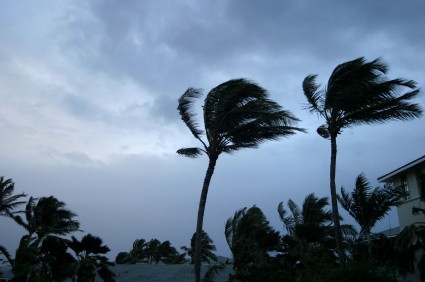 Elevated global temperatures bring a number of threats, including rising seas and more crop-withering heat waves. Higher surface water temperatures in the tropical oceans also provide more energy to drive tropical storm systems, leading to more-destructive hurricanes and typhoons. The combination of rising seas, more powerful storms, and stronger storm surges can be devastating.
Elevated global temperatures bring a number of threats, including rising seas and more crop-withering heat waves. Higher surface water temperatures in the tropical oceans also provide more energy to drive tropical storm systems, leading to more-destructive hurricanes and typhoons. The combination of rising seas, more powerful storms, and stronger storm surges can be devastating.
As noted in my most recent book, Plan B 3.0: Mobilizing to Save Civilization, just how devastating this combination can be became evident in late August 2005, when Hurricane Katrina came onshore on the U.S. Gulf Coast near New Orleans. In some Gulf Coast towns, Katrina’s powerful 28-foot-high storm surge did not leave a single structure standing. New Orleans survived the initial hit but was flooded when the inland levees were breached and water covered everything in large parts of the city except for the rooftops, where thousands of people were stranded. Even in August 2006, a year after the storm had passed, the most damaged areas of the city remained without water, power, sewage disposal, garbage collection, or telecommunications.
With advance warning of the storm and official urging to evacuate coastal areas, 1 million or so evacuees fled northward into Louisiana or to neighboring states of Texas and Arkansas. Of this total, more than 200,000 have not yet returned home and will likely never do so. These storm evacuees are the world’s first large wave of climate refugees.
Katrina was the most financially destructive hurricane ever to make landfall anywhere. It was one of eight hurricanes that hit the southeastern United States in 2004 and 2005. As a result of the unprecedented damage, insurance premiums have doubled, tripled, and even in some especially vulnerable situations gone up 10-fold. This enormous jump in insurance costs is lowering coastal real estate values and driving people and businesses out of highly exposed states like Florida.
The devastation caused by Katrina was not an isolated incident. In the fall of 1998, Hurricane Mitch—one of the most powerful storms ever to come out of the Atlantic, with winds approaching 200 miles per hour—hit the east coast of Central America. As atmospheric conditions stalled the normal northward progression of the storm, some 2 meters of rain were dumped on parts of Honduras and Nicaragua within a few days. The deluge collapsed homes, factories, and schools, leaving them in ruins. It destroyed roads and bridges. Seventy percent of the crops and much of the topsoil in Honduras were washed away—topsoil that had accumulated over long stretches of geological time. Huge mudslides destroyed villages, burying some local populations.
The storm left 11,000 dead. Thousands more, buried or washed out to sea, were never found. The basic infrastructure—the roads and bridges in Honduras and Nicaragua—was largely destroyed. President Flores of Honduras summed it up this way: “Overall, what was destroyed over several days took us 50 years to build.” The damage from this storm, exceeding the annual gross domestic product of the two countries, set their economic development back by 20 years.
In 2004, Japan experienced a record 10 typhoons (hurricanes) that collectively caused $10 billion worth of losses. During the same season, Florida was hit by 4 of the 10 most costly hurricanes in U.S. history. These 4 hurricanes together generated insurance claims of $22 billion.
Against this backdrop, insurance companies and reinsurance companies are finding it difficult to calculate a safe level of premiums, since the historical record traditionally used to calculate insurance fees is no longer a guide to the future. For example, the number of major flood disasters worldwide has grown over the last several decades, increasing from 6 major floods in the 1950s to 26 in the 1990s.
Insurers are convinced that with higher temperatures and more energy driving storm systems, future losses will be even greater. They are concerned about whether the industry can remain solvent under this onslaught of growing damages. So, too, is Moody’s Investors Service, which has several times downgraded the creditworthiness of some of the world’s leading reinsurance companies over the last six years.
Thomas Loster, a climate expert at Munich Re, a leading re-insurance company, says the overall balance of natural catastrophes is now “dominated by weather-related disasters, many of them exceptional and extreme. We need to stop this dangerous experiment humankind is conducting on the Earth’s atmosphere.”
Munich Re has published a list of natural disasters with insured losses of $1 billion or more. The first one came in 1983, when Hurricane Alicia struck the United States, racking up $1.5 billion in insured losses. Of the 58 natural catastrophes with $1 billion or more of insured losses recorded through the end of 2006, 3 were earthquakes, including the devastating 2004 earthquake-related Asian tsunami; the other 55 were weather-related—storms, floods, hurricanes, or wildfires. During the 1980s, there were 3 such events; during the 1990s, there were 26; and between 2000 and 2006 alone there were 26.
Prior to Hurricane Katrina, the two largest events in terms of total damage were Hurricane Andrew in 1992, which took down 60,000 homes and racked up $30 billion worth of damage, and the flooding of China’s Yangtze River basin in 1998, which also cost an estimated $30 billion, a sum comparable to the value of China’s rice harvest. Part of the growing damage toll is due to greater urban and industrial development in coastal areas and river floodplains. But part is due to more-destructive storms.
In the West, the regions most vulnerable to more powerful storms currently are the Atlantic and Gulf Coasts of the United States and the Caribbean countries. In the East, it is East and Southeast Asia, including China, Japan, the Philippines, Taiwan, and Viet Nam, that are likely to bear the brunt of the powerful storms crossing the Pacific. In the Bay of Bengal, Bangladesh and the east coast of India are particularly vulnerable.
Western Europe, traditionally experiencing a heavily damaging winter storm perhaps once in a century, had its first winter storm to exceed $1 billion in 1987—one that caused $3.7 billion of destruction, $3.1 billion of which was covered by insurance. Since then, Western Europe has had nine major winter storms with insured losses ranging from $1.3 billion to $5.9 billion.
As the climate changes, more extreme weather events are expected. Andrew Dlugolecki, a consultant on climate change and its effects on financial institutions, notes that damage from atmospherically related events has increased by roughly 10 percent a year. “If such an increase were to continue indefinitely,” he notes, “by 2065 storm damage would exceed the gross world product. The world obviously would face bankruptcy long before then.” Few double-digit annual growth trends continue for several decades, but Dlugolecki’s basic point is that climate change can be destructive, disruptive, and very costly.
If we allow the climate to spin out of our control, we risk huge financial costs. In a late 2006 report, former World Bank chief economist Nicholas Stern projected that the long-term costs of climate change could exceed 20 percent of gross world product (GWP). By comparison, the near-term costs of cutting greenhouse gas emissions to stabilize climate, which Stern now estimates at close to 2 percent of GWP, would be a bargain.




